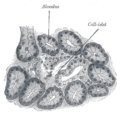Duct (anatomy)
Duct (anatomy)
A duct in anatomy is a passage with well-defined walls, especially a tubular structure for the passage of excretions or secretions. Ducts are found throughout the body and serve a variety of functions, including the transport of bodily fluids and the facilitation of certain metabolic processes.
Types of Ducts[edit]
There are several types of ducts in the human body, each serving a unique function. Some of the most notable include:
- Bile ducts: These ducts carry bile from the liver and gallbladder to the duodenum, which is the first part of the small intestine. Bile aids in the digestion and absorption of fats.
- Duct of Bellini: Located in the kidneys, these ducts are the final portion of the urinary tract, carrying urine from the collecting ducts to the renal pelvis.
- Ejaculatory duct: In males, these ducts transport sperm and seminal vesicle fluid to the urethra.
- Lactiferous duct: These ducts are found in the breasts and carry milk from the mammary glands to the nipple.
- Pancreatic duct: This duct carries digestive enzymes and bicarbonate from the pancreas to the duodenum.
Function of Ducts[edit]
Ducts serve as pathways for the transport of various bodily fluids. They are integral to the functioning of many bodily systems, including the digestive, urinary, and reproductive systems. The structure and function of ducts can vary widely depending on their location and the specific substances they transport.
Diseases and Disorders[edit]
Ducts can be affected by a variety of diseases and disorders. For example, blockages can occur, leading to conditions such as gallstones or pancreatitis. Inflammation of the ducts, known as ductitis, can also occur. Certain cancers, such as breast cancer and pancreatic cancer, can originate in the ducts.
See Also[edit]
-
Dissected lactating breast
-
Gray's Anatomy illustration of the liver
-
Gray's Anatomy illustration of the pancreas
-
Gray's Anatomy illustration of the salivary glands
-
Gray's Anatomy illustration of the bile duct
-
Centroacinar cells in the pancreas
-
Striated duct in the parotid gland
Ad. Transform your life with W8MD's Budget GLP-1 injections from $75


W8MD offers a medical weight loss program to lose weight in Philadelphia. Our physician-supervised medical weight loss provides:
- Weight loss injections in NYC (generic and brand names):
- Zepbound / Mounjaro, Wegovy / Ozempic, Saxenda
- Most insurances accepted or discounted self-pay rates. We will obtain insurance prior authorizations if needed.
- Generic GLP1 weight loss injections from $75 for the starting dose.
- Also offer prescription weight loss medications including Phentermine, Qsymia, Diethylpropion, Contrave etc.
NYC weight loss doctor appointmentsNYC weight loss doctor appointments
Start your NYC weight loss journey today at our NYC medical weight loss and Philadelphia medical weight loss clinics.
- Call 718-946-5500 to lose weight in NYC or for medical weight loss in Philadelphia 215-676-2334.
- Tags:NYC medical weight loss, Philadelphia lose weight Zepbound NYC, Budget GLP1 weight loss injections, Wegovy Philadelphia, Wegovy NYC, Philadelphia medical weight loss, Brookly weight loss and Wegovy NYC
|
WikiMD's Wellness Encyclopedia |
| Let Food Be Thy Medicine Medicine Thy Food - Hippocrates |
Medical Disclaimer: WikiMD is not a substitute for professional medical advice. The information on WikiMD is provided as an information resource only, may be incorrect, outdated or misleading, and is not to be used or relied on for any diagnostic or treatment purposes. Please consult your health care provider before making any healthcare decisions or for guidance about a specific medical condition. WikiMD expressly disclaims responsibility, and shall have no liability, for any damages, loss, injury, or liability whatsoever suffered as a result of your reliance on the information contained in this site. By visiting this site you agree to the foregoing terms and conditions, which may from time to time be changed or supplemented by WikiMD. If you do not agree to the foregoing terms and conditions, you should not enter or use this site. See full disclaimer.
Credits:Most images are courtesy of Wikimedia commons, and templates, categories Wikipedia, licensed under CC BY SA or similar.
Translate this page: - East Asian
中文,
日本,
한국어,
South Asian
हिन्दी,
தமிழ்,
తెలుగు,
Urdu,
ಕನ್ನಡ,
Southeast Asian
Indonesian,
Vietnamese,
Thai,
မြန်မာဘာသာ,
বাংলা
European
español,
Deutsch,
français,
Greek,
português do Brasil,
polski,
română,
русский,
Nederlands,
norsk,
svenska,
suomi,
Italian
Middle Eastern & African
عربى,
Turkish,
Persian,
Hebrew,
Afrikaans,
isiZulu,
Kiswahili,
Other
Bulgarian,
Hungarian,
Czech,
Swedish,
മലയാളം,
मराठी,
ਪੰਜਾਬੀ,
ગુજરાતી,
Portuguese,
Ukrainian








